Prenucleation at the Liquid/Substrate Interface: An Overview
Abstract
1. Introduction
2. Historical Development
2.1. The “Hard Wall” Effect
2.2. Atomistic Simulations
2.3. Experimental Observations
3. Recent Advances
3.1. Concept of Prenucleation
3.1.1. Layering and In-Plane Atomic Ordering
3.1.2. Two-Dimensional Ordered Structure
3.1.3. Diffuse Liquid/Substrate Interface

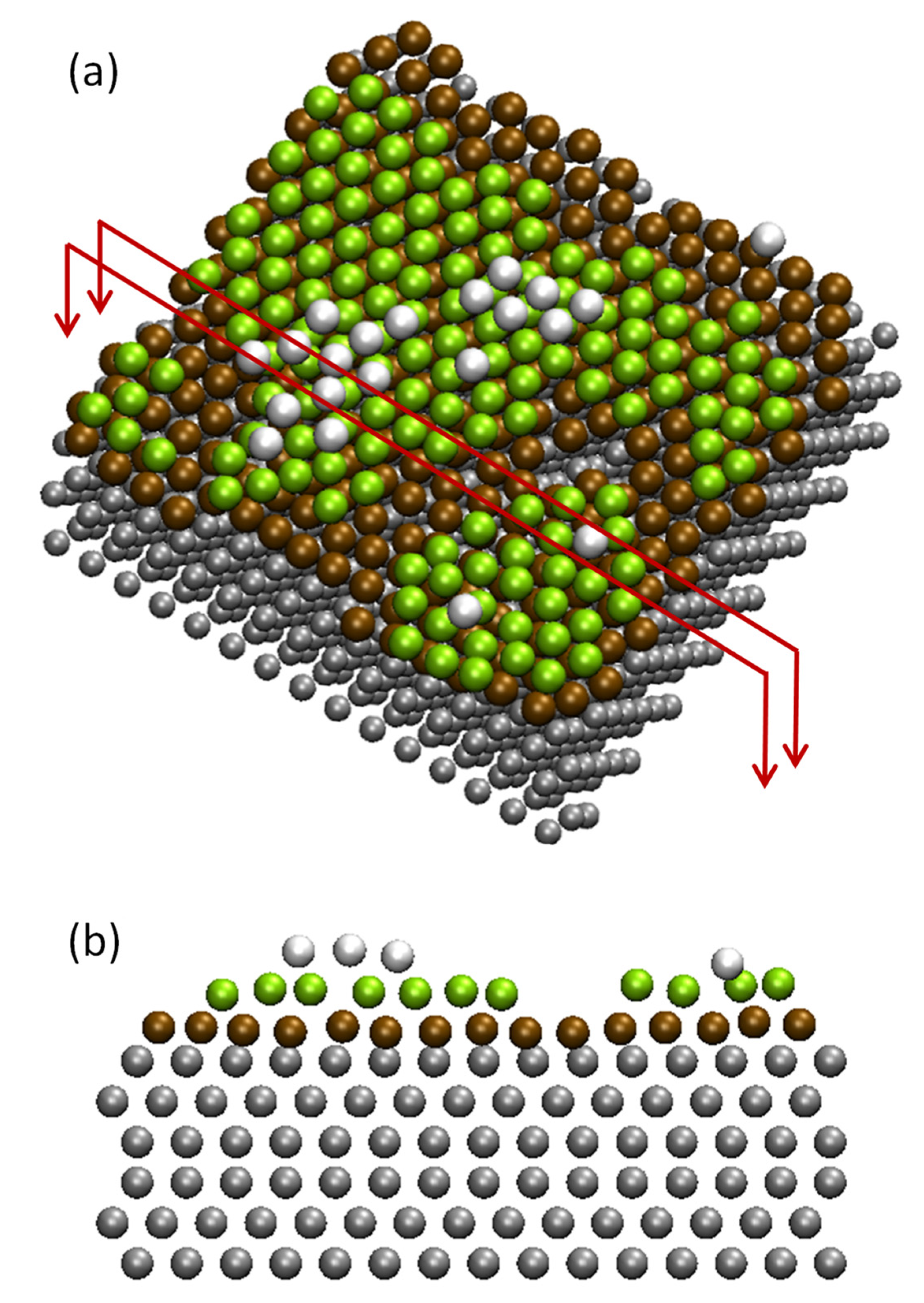
3.2. Effect of Temperature
3.3. Effect of Lattice Misfit
3.3.1. Prenucleation on Substrates with Small Negative Misfit (−12.5% < f < 0)
3.3.2. Prenucleation on Substrates with Small Positive Misfit (0% < f < 12.5%)
3.3.3. Prenucleation on Substrates with Large Misfit (|f| > 12.5%)
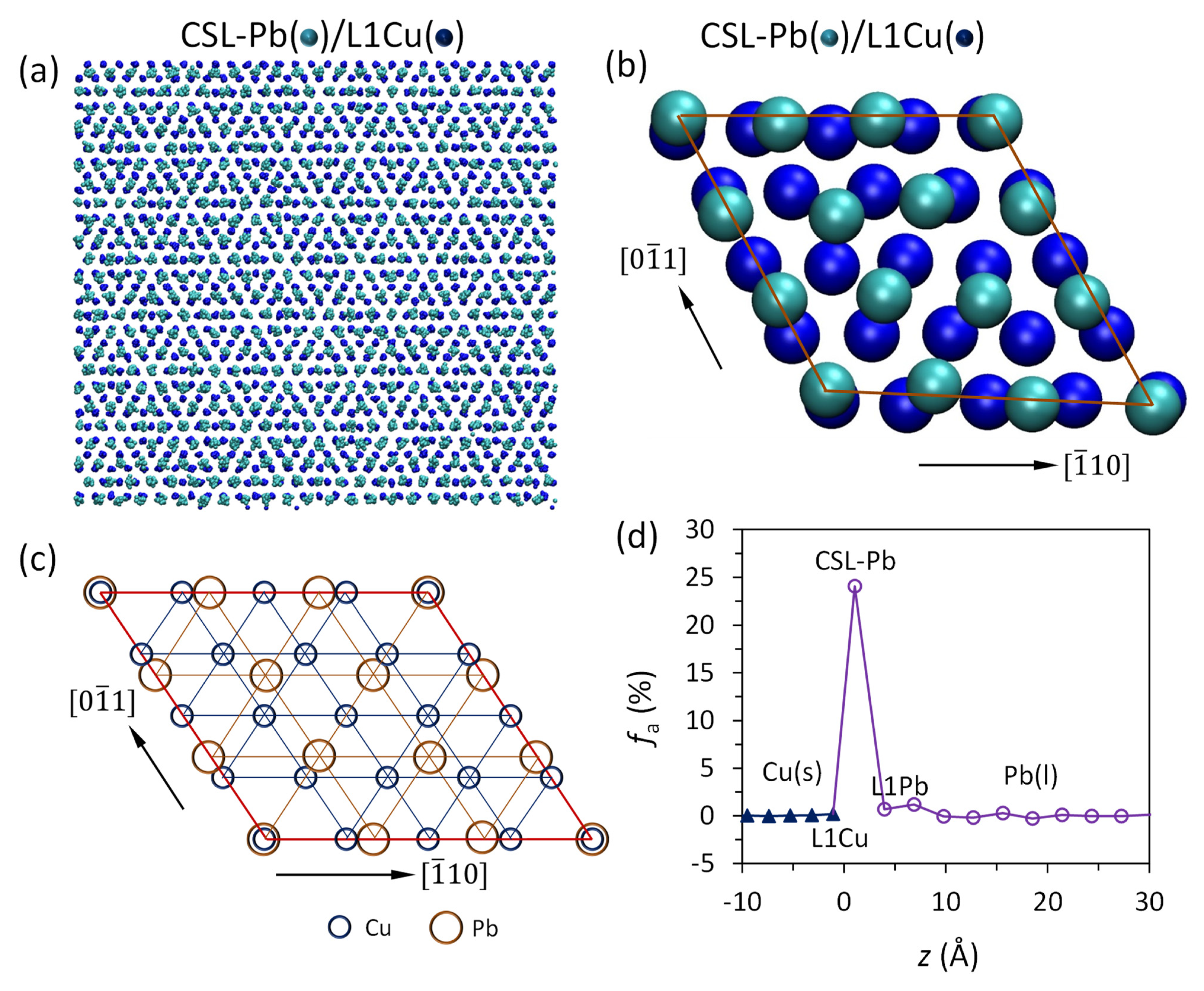
3.3.4. Prenucleation on Amorphous Substrates
3.4. Effect of Chemistry
3.5. Effect of Substrate Roughness
3.5.1. Amorphous Substrate
3.5.2. Crystalline Substrate

3.6. Prenucleation at Liquid/Oxide Interface
3.7. Manipulation of Substrate Potency by Interfacial Segregation
- Reaction with the solvent to form an intermetallic phase on the substrate;
- Reaction with the substrate to form a new compound on the substrate;
- Segregation at the interface to influence the lattice parameter of the solid phase;
- Dissolution into the substrate to change the lattice parameter of the substrate.
4. Discussion
4.1. Prenucleation Describes the Phenomenon of Substrate-Induced Interfacial Atomic Ordering
4.2. Prenucleation Provides a Precursor for Heterogeneous Nucleation
4.3. Prenucleation Leads to the Lowest γLN at the Nucleation Temperature
4.4. Prenucleation Originates Physically from Structural Templating
5. Summary
- Prenucleation describes the phenomenon of substrate-induced atomic ordering in the liquid at the liquid/substrate interface at temperature above the nucleation temperature.
- Prenucleation can be described in three different ways depending on the purpose of analysis: (1) atomic layering and in-plane atomic ordering for quantifying the substrate induce atomic ordering; (2) two-dimensional order structure at the liquid/substrate interface for describing the interfacial atomic arrangement; and (3) a diffuse liquid/substrate interface for linking interfacial atomic ordering with interfacial energies.
- Prenucleation is promoted by reducing the temperature, lattice misfit, or atomic-level surface roughness and by having an attractive chemical interaction between the substrate and liquid atoms.
- The physical origin of in-plane atomic ordering during prenucleation is structural templating by the substrate lattice, while that of atomic layering is the “hard wall” effect.
- While structural templating dictates prenucleation, the chemistry effect is a secondary factor in determining the atomic ordering at the liquid/substrate interface. An attractive chemical interaction strengthens structural templating, and a repulsive interaction weakens it.
- Atomic ordering at the liquid/substrate interface can be demolished by impeding the “hard wall” effect and/or structural templating with an atomically rough substrate surface. Increasing the surface roughness of a crystalline substrate reduces both atomic layering and in-plane atomic ordering.
- The rough surface of an amorphous substrate can eliminate in-plane ordering in the liquid at the liquid/substrate interface, resulting in such a substrate having no structural templating power.
- The nucleation potency of a substrate can be manipulated by the segregation of selected elements at the liquid/substrate interface in such a way that nucleation is either enhanced or impeded through prenucleation.
Author Contributions
Funding
Data Availability Statement
Conflicts of Interest
References
- Kelton, K.F.; Greer, A.L. Nucleation in Condensed Matter: Applications in Materials and Biology; Elsevier Science: Oxford, UK, 2010. [Google Scholar]
- Kashchiev, D. Nucleation: Theory with Applications; Butterworth-Heinemann: Oxford, UK, 2000. [Google Scholar]
- Bartels-Rausch, T. Chemistry: Ten things we need to know about ice and snow. Nature 2013, 494, 27–29. [Google Scholar] [CrossRef] [PubMed]
- Sosso, G.C.; Chen, J.; Cox, S.J.; Fitzner, M.; Pedevilla, P.; Zen, A.; Michaelides, A. Crystal nucleation in liquids: Open questions and future challenges in molecular dynamics simulations. Chem. Rev. 2016, 116, 7078–7116. [Google Scholar] [CrossRef] [PubMed]
- Greer, A.L. Overview: Application of heterogeneous nucleation in grain-refining of metals. J. Chem. Phys. 2016, 145, 211704. [Google Scholar] [CrossRef] [PubMed]
- Erdemir, D.; Lee, A.Y.; Myerson, A.S. Polymorph selection: The role of nucleation, crystal growth and molecular modelling. Curr. Opin. Drug Discov. Devel. 2007, 10, 746–755. [Google Scholar]
- Michaels, T.C.T.; Šarić, A.; Curk, S.; Bernfur, K.; Arosio, P.; Meisl, G.; Dear, A.J.; Cohen, S.I.A.; Dobson, C.M.; Vendruscolo, M.; et al. Dynamics of oligomer populations formed during the aggregation of Alzheimer’s Aβ42 peptide. Nat. Chem. 2020, 12, 445–451. [Google Scholar] [CrossRef]
- Easton, M.A.; Qian, M.; Prasad, A.; StJohn, D.H. Recent advances in grain refinement of light metals and alloys. Curr. Opin. Solid State Mater. Sci. 2016, 20, 13–24. [Google Scholar] [CrossRef]
- Kaplan, W.D.; Kauffmann, Y. Structural order in liquids induced by interfaces with crystal. Annu. Rev. Mater. Res. 2006, 36, 1–48. [Google Scholar] [CrossRef]
- Asta, M.; Spaepen, F.; van der Veen, J.F. Solid-liquid interfaces: Molecular structure, thermodynamics, and crystallization. MRS Bull. 2004, 29, 920–926. [Google Scholar] [CrossRef][Green Version]
- Fan, Z. An epitaxial model for heterogeneous nucleation on potent substrates. Metall. Mater. Trans. A 2013, 44, 1409–1418. [Google Scholar] [CrossRef]
- Oh, S.H.; Kauffmann, Y.; Scheu, C.; Kaplan, W.D.; Rühle, M. Ordered liquid aluminium at the interface with sapphire. Science 2005, 310, 661–663. [Google Scholar] [CrossRef]
- Oh, S.H.; Scheu, C.; Rühle, M. In-situ HRTEM studies of alumina-aluminium solid-liquid interfaces. Korean J. Electron Microsc. Spec. Issue 2006, 1, 19–24. [Google Scholar]
- Hashibon, A.; Adler, J.; Finnis, M.W.; Kaplan, W.D. Ordering at solid-liquid interfaces between dissimilar materials. Interface Sci. 2001, 9, 175–181. [Google Scholar] [CrossRef]
- Hashibon, A.; Adler, J.; Finnis, M.W.; Kaplan, W.D. Atomistic study of structural correlations at a liquid-solid interface. Comp. Mater. Sci. 2002, 24, 443–452. [Google Scholar] [CrossRef]
- Palafox-Hernandez, J.P.; Laird, B.B.; Asta, M. Atomistic characterization of the Cu-Pb solid-liquid interface. Acta Mater. 2011, 59, 3137–3144. [Google Scholar] [CrossRef]
- Wang, J.S.; Horsfield, A.; Schwingenschlögl, U.; Lee, P.D. Heterogeneous nucleation of solid Al from the melt by Al3Ti: Molecular dynamics simulations. Phys. Rev. B 2010, 82, 184203. [Google Scholar]
- Men, H.; Fan, Z. Prenucleation induced by crystalline substrates. Metall. Mater. Trans. A 2018, 49, 2766–2777. [Google Scholar] [CrossRef]
- Gebauer, D.; Völkel, A.; Cölfen, H. Stable prenucleation calcium carbonate clusters. Science 2008, 322, 1819–1822. [Google Scholar] [CrossRef]
- Turnbull, D.; Vonnegut, B. Nucleation catalysis. Ind. Eng. Chem. 1952, 44, 1292–1298. [Google Scholar] [CrossRef]
- Wang, L.; Yang, L.; Zhang, D.; Xia, M.; Wang, Y.; Li, J.G. The role of lattice misfit on heterogeneous nucleation of pure aluminium. Metall. Mater. Trans. A 2016, 47, 5012–5022. [Google Scholar] [CrossRef]
- Wang, L.; Lu, W.Q.; Hu, Q.D.; Xia, M.X.; Wang, Y.; Li, J.G. Interfacial tuning for the nucleation of liquid AlCu alloy. Acta Mater. 2017, 139, 75–85. [Google Scholar] [CrossRef]
- Tóth, G.I.; Tegze, G.; Pusztai, T.; Gránásy, L. Heterogeneous crystal nucleation: The effect of lattice mismatch. Phys. Rev. Lett. 2012, 108, 025502. [Google Scholar] [CrossRef]
- Fan, Z.; Men, H. A molecular dynamics study of heterogeneous nucleation in generic liquid/substrate systems with positive lattice misfit. Mater. Res. Express 2020, 7, 126501. [Google Scholar] [CrossRef]
- Jiang, B.; Men, H.; Fan, Z. Atomic ordering in the liquid adjacent to an atomically rough solid surface. Comput. Mater. Sci. 2018, 153, 73–81. [Google Scholar] [CrossRef]
- Fang, C.M.; Men, H.; Fan, Z. Effect of substrate chemistry on prenucleation. Metall. Mater. Trans. A 2018, 49, 6231–6242. [Google Scholar] [CrossRef]
- Men, H.; Fan, Z. Heterogeneous nucleation mechanisms in systems with large lattice misfit demonstrated by the Pb(l)/Cu(s) system. Metals 2022, 12, 1583. [Google Scholar] [CrossRef]
- Henderson, D.; Abraham, F.F.; Barker, J.A. The Ornstein-Zernike equation for a fluid in contact with a surface. Mol. Phys. 1976, 31, 1291. [Google Scholar] [CrossRef]
- Abrahama, F.F.; Singh, Y. The structure of a hard-sphere fluid in contact with a soft repulsive wall. J. Chem. Phys. 1977, 67, 2384–2385. [Google Scholar] [CrossRef]
- Abraham, F.F.; Singh, Y. Comment on “The structure of a hard sphere fluid in contact with a soft repulsive wall”. J. Chem. Phys. 1978, 68, 4767–4768. [Google Scholar] [CrossRef]
- Donnelly, S.E.; Birtcher, R.C.; Allen, C.W.; Morrison, I.; Furuya, K.; Song, M.H.; Mitsuishi, K.; Dahmen, U. Ordering in a fluid inert gas confined by flat surfaces. Science 2002, 296, 507–510. [Google Scholar] [CrossRef]
- Fischer, J.; Methfessel, M. Born-Green-Yvon approach to the local densities of a fluid at interfaces. Phys. Rev. A 1980, 22, 2836–2843. [Google Scholar] [CrossRef]
- Rull, L.F.; Toxvaerd, S. The structure and thermodynamics of a solid–fluid interface. J. Chem. Phys. 1983, 78, 3273–3278. [Google Scholar] [CrossRef]
- Kyrlidis, A.; Brown, R.A. Density functional theory and atomistic simulation of the hard-sphere melt-solid interface. Phys. Rev. E 1995, 51, 5832–5845. [Google Scholar] [CrossRef] [PubMed]
- Geysermans, P.; Gorse, D.; Pontikis, V. Molecular dynamics study of the solid-liquid interface. J. Chem. Phys. 2000, 113, 6382–6389. [Google Scholar] [CrossRef]
- Magnussen, O.M.; Ocko, B.M.; Regan, M.J.; Penanen, K.; Pershan, P.S.; Deutsch, M. X-ray reflectivity measurements of surface layering in liquid mercury. Phys. Rev. Lett. 1995, 74, 4444–4447. [Google Scholar] [CrossRef] [PubMed]
- Regan, M.J.; Kawamoto, E.H.; Lee, S.; Pershan, P.S.; Maskil, N.; Deutsch, M.; Magnussen, O.M.; Ocko, B.M.; Berman, L.E. Surface layering in liquid gallium: An X-Ray reflectivity study. Phys. Rev. Lett. 1995, 75, 2498–2501. [Google Scholar] [CrossRef] [PubMed]
- Shpyrko, O.G.; Grigoriev, A.Y.; Steimer, C.; Pershan, P.S.; Lin, B.; Meron, M.; Graber, T.; Gerbhardt, J.; Ocko, B.; Deutsch, M. Anomalous layering at the liquid Sn surface. Phys. Rev. B 2004, 70, 224206. [Google Scholar] [CrossRef]
- Huisman, W.J.; Peters, J.F.; Zwanenburg, M.J.; de Vries, S.A.; Derry, T.E.; Abernathy, D.; van der Veen, J.F. Layering of a liquid metal in contact with a hard wall. Nature 1997, 390, 379–381. [Google Scholar] [CrossRef]
- Yu, C.J.; Richter, A.G.; Datta, A.; Durbin, M.K.; Dutta, P. Observation of molecular layering in thin liquid films using X-ray reflectivity. Phys. Rev. Lett. 1999, 82, 2326–2329. [Google Scholar] [CrossRef]
- Reichert, H.; Klein, O.; Dosch, H.; Denk, M.; Honkimäki, V.; Lippmann, T.; Reiter, G. Observation of five-fold local symmetry in liquid lead. Nature 2000, 408, 839–841. [Google Scholar] [CrossRef]
- Doerr, A.K.; Tolan, M.; Schlomka, J.P.; Press, W. Evidence for density anomalies of liquids at the solid/liquid interface. Euro. Phys. Lett. 2000, 52, 330–336. [Google Scholar] [CrossRef]
- Grey, F.; Feidenhans’l, R.; Pedersen, J.S.; Nielsen, M.; Johnson, R.L. Pb/Ge(111) 1 × 1: An anisotropic two-dimensional liquid. Phys. Rev. B 1990, 41, 9519–9522. [Google Scholar] [CrossRef]
- Huisman, W.J.; Peters, J.F.; Derks, J.W.; Ficke, H.G.; Abernathy, D.L.; van der Veen, J.F. A new X-ray diffraction method for structural investigations of solid-liquid interfaces. Rev. Sci. Instrum. 1997, 68, 4169–4176. [Google Scholar] [CrossRef]
- Huisman, W.J.; van der Veen, J.F. Modelling the atomic density across a solid-liquid interface. Surf. Sci. 1998, 404, 866–870. [Google Scholar] [CrossRef]
- Reedijk, M.F.; Arsic, J.; Theije, F.K.d.; McBride, M.T.; Peters, K.F.; Vlieg, E. Structure of liquid Sn on Ge(111). Phys. Rev. B 2001, 64, 033403. [Google Scholar] [CrossRef]
- Reedijk, M.F.; Arsic, J.; Hollander, F.F.A.; de Vries, S.A.; Vlieg, E. Liquid order at the interface of KDP crystals with water: Evidence for icelike layers. Phys. Rev. Lett. 2003, 90, 066103. [Google Scholar] [CrossRef]
- Schülli, T.U.; Daudin, R.; Renaud, G.; Vaysset, A.; Geaymond, O.; Pasturel, A. Substrate-enhanced supercooling in AuSi eutectic droplets. Nature 2010, 464, 1174–1177. [Google Scholar] [CrossRef]
- Hohenberg, P.; Kohn, W. Inhomogeneous electron gas. Phys. Rev. 1964, 136, B864–B871. [Google Scholar] [CrossRef]
- Kohn, W.; Sham, L.J. Self-consistent equations including exchange and correlation effects. Phys. Rev. 1965, 140, A1133–A1138. [Google Scholar] [CrossRef]
- McMullen, W.E.; Oxtoby, D.W. A density functional approach to freezing transitions in molecular fluids: Dipolar hard spheres. J. Chem. Phys. 1987, 86, 4146–4156. [Google Scholar] [CrossRef]
- Curtin, W.A. Density-functional theory of the solid-liquid interface. Phys. Rev. Lett. 1987, 59, 1228–1231. [Google Scholar] [CrossRef]
- Sikkenk, J.H.; Indekeu, J.O.; van Leeuwen, J.M.J.; Vossnack, E.O. Molecular-dynamics simulation of wetting and drying at solid-fluid interfaces. Phys. Rev. Lett. 1987, 59, 98–101. [Google Scholar] [CrossRef]
- Ma, W.-J.; Banavar, J.R.; Koplik, J. A molecular dynamics study of freezing in a confined geometry. J. Chem. Phys. 1992, 97, 485–493. [Google Scholar] [CrossRef]
- Hook, J.R.; Hall, H.E. Solid State Physics, 2nd ed.; Wiley: Chichester, UK, 1991. [Google Scholar]
- Steinhardt, P.J.; Nelson, D.R.; Ronchetti, M. Bond-orientational order in liquids and glasses. Phys. Rev. B 1983, 28, 784–805. [Google Scholar] [CrossRef]
- Ten Wolde, P.R.; Ruiz-Montero, M.J.; Frenkel, D. Numerical evidence for bcc ordering at the surface of a critical fcc nucleus. Phys. Rev. Lett. 1995, 75, 2714–2717. [Google Scholar] [CrossRef]
- Auer, S.; Frenkel, D. Numerical prediction of absolute crystallization rates in hard-sphere colloids. J. Chem. Phys. 2004, 120, 3015–3029. [Google Scholar] [CrossRef]
- Auer, S.; Frenkel, D. Prediction of absolute crystal-nucleation rate in hard-sphere colloids. Nature 2001, 409, 1020–1023. [Google Scholar] [CrossRef]
- Zope, R.R.; Mishin, Y. Interatomic potentials for atomistic simulations of the Ti-Al system. Phys. Rev. B 2003, 68, 024102. [Google Scholar] [CrossRef]
- Hoyt, J.J.; Garvin, J.W.; Webb III, E.B.; Asta, M. An embedded atom method interatomic potential for the Cu-Pb system. Model. Simul. Mater. Sci. Eng. 2003, 11, 287–299. [Google Scholar] [CrossRef]
- Plimpton, S. Fast parallel algorithms for short-range molecular dynamics. J. Comput. Phys. 1995, 117, 1–19. [Google Scholar] [CrossRef]
- Grimmer, H.; Bollmann, W.; Warrington, D.H. Coincidence-site lattices and complete pattern-shift in cubic crystals. Acta Crystallogr. A 1974, 30, 197–207. [Google Scholar] [CrossRef]
- Men, H.; Fan, Z. Molecular dynamics simulations on effect of surface roughness of amorphous substrate on nucleation in liquid Al. Metals 2022, 12, 1529. [Google Scholar] [CrossRef]
- Blöchl, P.E. Projector augmented-wave method. Phys. Rev. B 1994, 50, 17953–17979. [Google Scholar] [CrossRef] [PubMed]
- Kresse, G.; Joubert, J. From ultrasoft pseudopotentials to the projector augmented-wave method. Phys. Rev. B 1999, 59, 1758–1775. [Google Scholar] [CrossRef]
- Perdew, J.P.; Burke, K.; Ernzerhof, M. Generalized gradient approximation made simple. Phys. Rev. Lett. 1996, 77, 3865–3868. [Google Scholar] [CrossRef]
- Rosato, V.; Guillope, M.; Legrand, B. Thermodynamical and structural properties of f.c.c. transition metals using a simple tight-binding model. Philos. Mag. A 1989, 59, 321–336. [Google Scholar] [CrossRef]
- Wang, S.H.; Wang, Y.; Ramasse., Q.; Fan, Z. The nature of native MgO in Mg and its alloys. Metal. Mater. Trans. A 2020, 51, 2957–2974. [Google Scholar] [CrossRef]
- Li, H.-T.; Wang, Y.; Fan, Z. Mechanisms of enhanced heterogeneous nucleation during solidification in binary Al-Mg alloys. Acta Mater. 2012, 60, 1528–1537. [Google Scholar] [CrossRef]
- Wang, Y.; Fan, Z.; Zhou, X.; Thompson, G.E. Characterisation of magnesium oxide and its interface with α-Mg in Mg-Al-based alloys. Phil. Mag. Lett. 2011, 91, 516–529. [Google Scholar] [CrossRef]
- Wang, Y.; Li, H.-T.; Fan, Z. Oxidation of aluminium alloy melts and inoculation by oxide particles. Trans. Indian Inst. Met. 2021, 65, 653–661. [Google Scholar] [CrossRef]
- Kim, K. Formation of endogenous MgO and MgAl2O4 particles and their possibility of acting as substrate for heterogeneous nucleation of aluminum grains. Surf. Interface Anal. 2015, 47, 429–438. [Google Scholar] [CrossRef]
- Fang, C.M.; Fan, Z. Prenucleation at the interface between MgO and liquid magnesium: An ab initio molecular dynamics study. Metal. Mater. Trans. A 2020, 51, 788–797. [Google Scholar] [CrossRef]
- Fang, C.M.; Fan, Z. Prenucleation at the liquid-Al/α-Al2O3 and the liquid-Al/MgO interfaces. Comp. Mater. Sci. 2020, 171, 109258. [Google Scholar] [CrossRef]
- Fang, C.M.; Fan, Z. Atomic ordering at the interfaces between liquid Al and MgO: An ab initio molecular dynamics study. Philos. Mag. Lett. 2020, 100, 235–244. [Google Scholar] [CrossRef]
- Fang, C.M.; Yasmin, S.; Fan, Z. Interfacial interaction and prenucleation at liquid-Al/γ-Al2O3{1 1 1} interfaces from ab initio molecular dynamics simulations. J. Phys. Commun. 2021, 5, 015007. [Google Scholar] [CrossRef]
- Fang, C.M.; Fan, Z. Atomic ordering at the Liquid-Al/MgAl2O4{111} Interfaces: Ab initio molecular dynamics simulations. Metal. Mater. Trans. A 2020, 51, 6318–6326. [Google Scholar] [CrossRef]
- Verwey, E.J.W. The crystal structure of γ-Fe2O3 and γ-Al2O3. J. Z. Krist. 1935, 91, 65–69. [Google Scholar] [CrossRef]
- Gibbs, J. The Collected Works of J. Willard Gibbs; Langman, Green and Co.: New York, NY, USA, 1928; Volume 1. [Google Scholar]
- Men, H.; Fan, Z. An analytical model for solute segregation at liquid metal/solid substrate interface. Metall. Mater. Trans. A 2014, 45, 5508–5516. [Google Scholar] [CrossRef]
- Fan, Z.; Wang, Y.; Zhang, Y.; Qin, T.; Zhou, X.R.; Thompson, G.E.; Pennycook, T.; Hashimoto, T. Grain refining mechanism in the Al/Al–Ti–B system. Acta Mater. 2015, 84, 292–304. [Google Scholar] [CrossRef]
- Wang, Y.; Fang, C.M.; Zhou, L.; Hashimoto, T.; Zhou, X.; Ramasse, Q.M.; Fan, Z. Mechanism for Zr poisoning of Al-Ti-B based grain refiners. Acta Mater. 2019, 164, 428–439. [Google Scholar] [CrossRef]
- Jones, G.P.; Pearson, J. Factors affecting the grain-refinement of aluminium using titanium and boron additives. Metall. Trans. B 1976, 7, 223–234. [Google Scholar] [CrossRef]
- Jones, G.P. Solidification Processing 1987; The Institute of Metals: London, UK, 1988; p. 496. [Google Scholar]
- Greer, A.L.; Bunn, A.M.; Tronche, A.; Evans, P.V.; Bristow, D.J. Modelling of inoculation of metallic melts: Application to grain refinement of aluminium by Al-Ti-B. Acta Mater. 2000, 48, 2823–2835. [Google Scholar] [CrossRef]
- Quested, T.E.; Greer, A.L. The effect of the size distribution of inoculant particles on as-cast grain size in aluminium alloys. Acta Mater. 2004, 52, 3859–3868. [Google Scholar] [CrossRef]
- Kelton, K.F.; Greer, A.L.; Herlach, D.M.; Holland-Moritz, D. The influence of order on the nucleation barrier. MRS Bull. 2004, 29, 940–944. [Google Scholar] [CrossRef]
- Fan, Z.; Men, H. An overview on atomistic mechanisms of heterogeneous nucleation. Metals 2022, 12, 1547. [Google Scholar] [CrossRef]
- Fan, Z.; Men, H. Heterogeneous nucleation and grain initiation on a single substrate. Metals 2022, 12, 1454. [Google Scholar] [CrossRef]
- Fan, Z.; Men, H.; Wang, Y.; Que, Z.P. A new atomistic mechanism for heterogeneous nucleation in the systems with negative lattice misfit: Creating a 2D template for crystal growth. Metals 2021, 11, 478. [Google Scholar] [CrossRef]
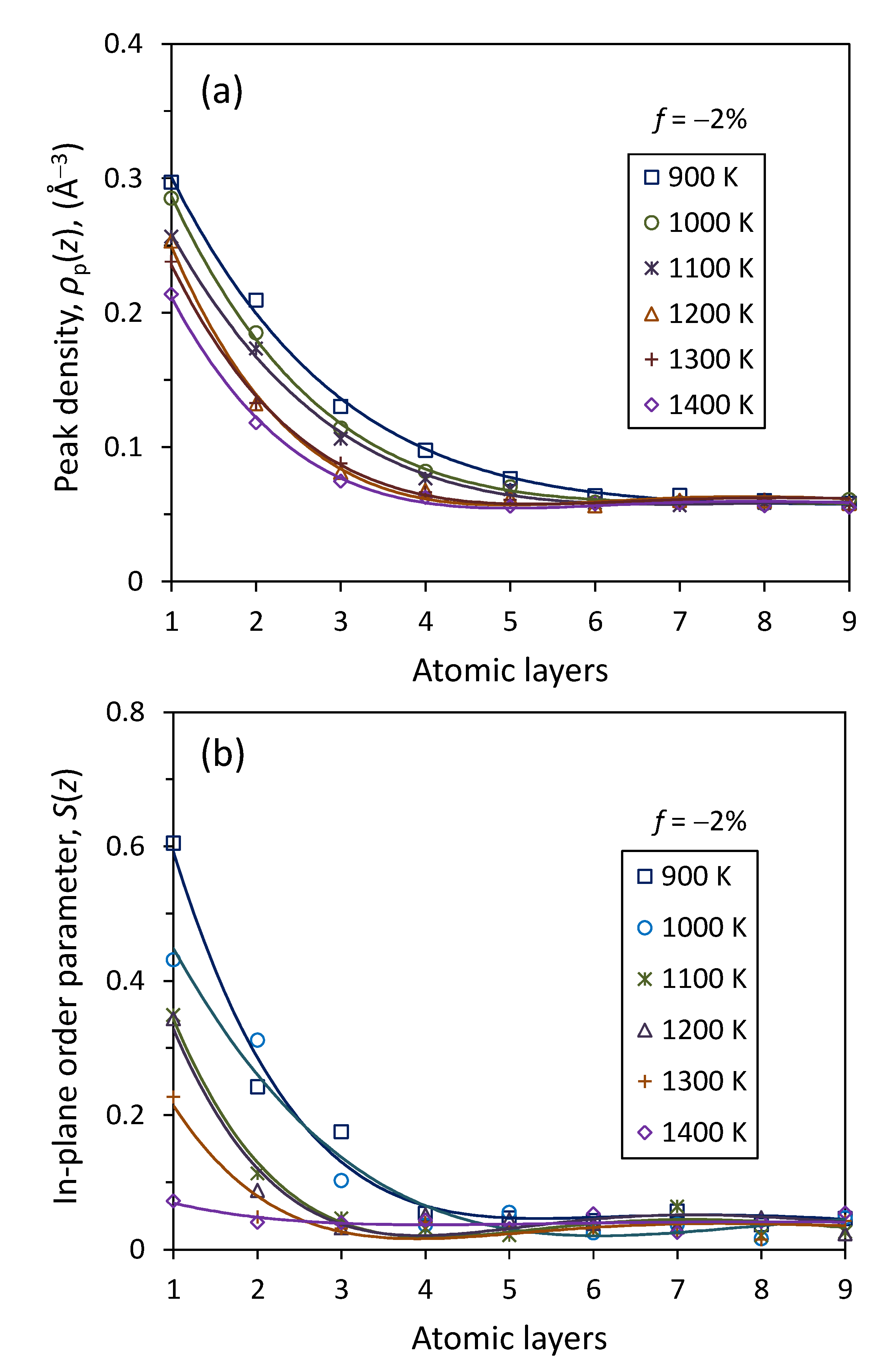
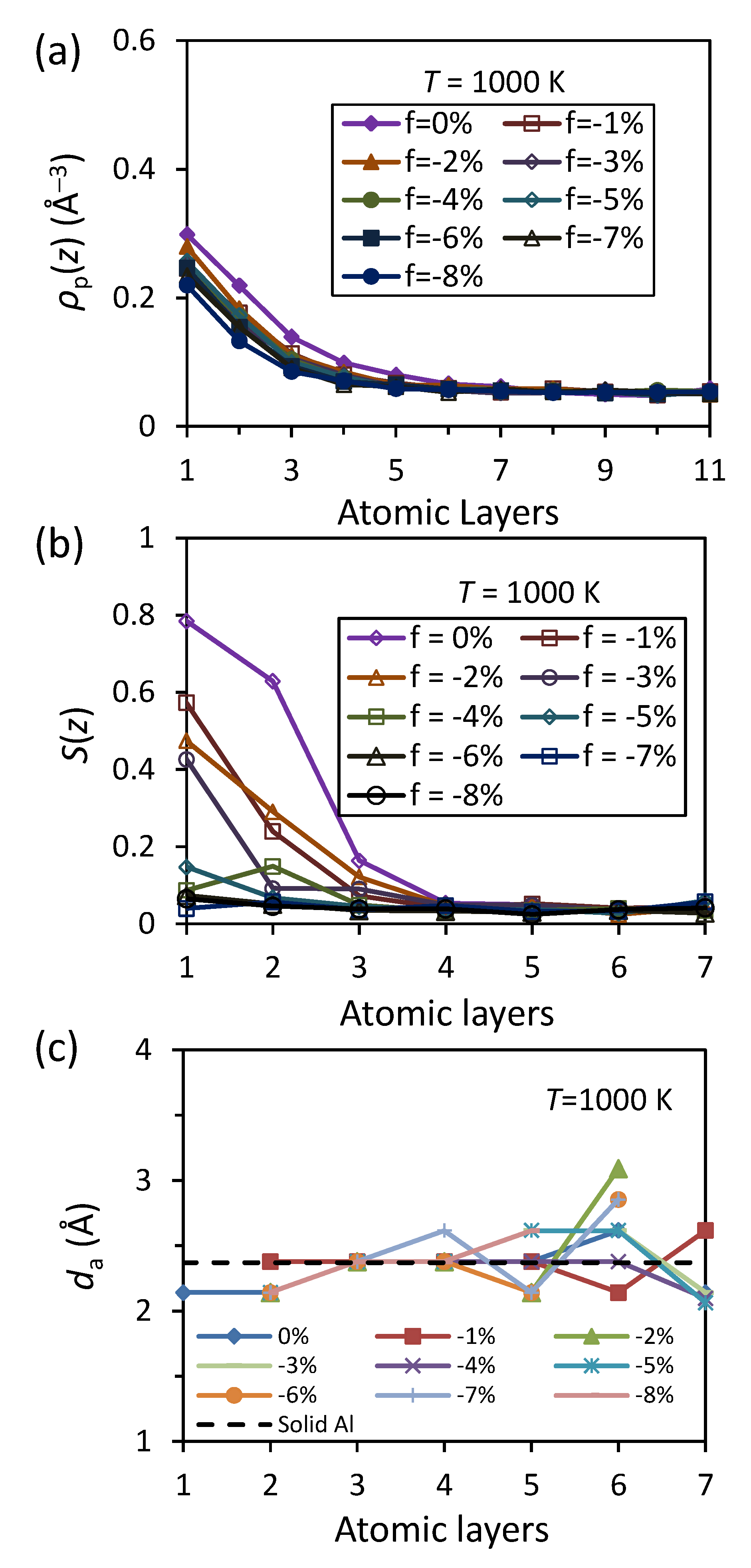
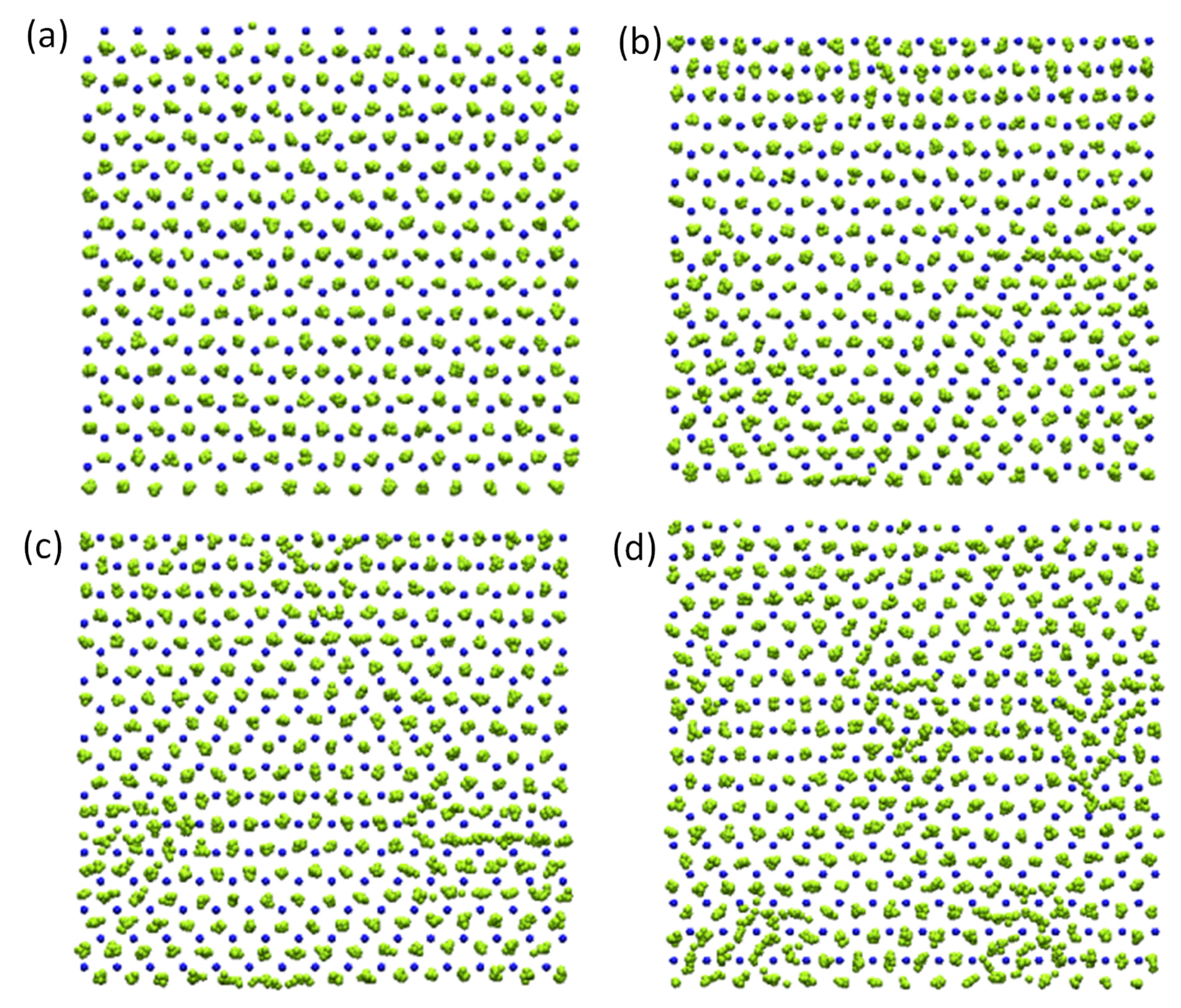
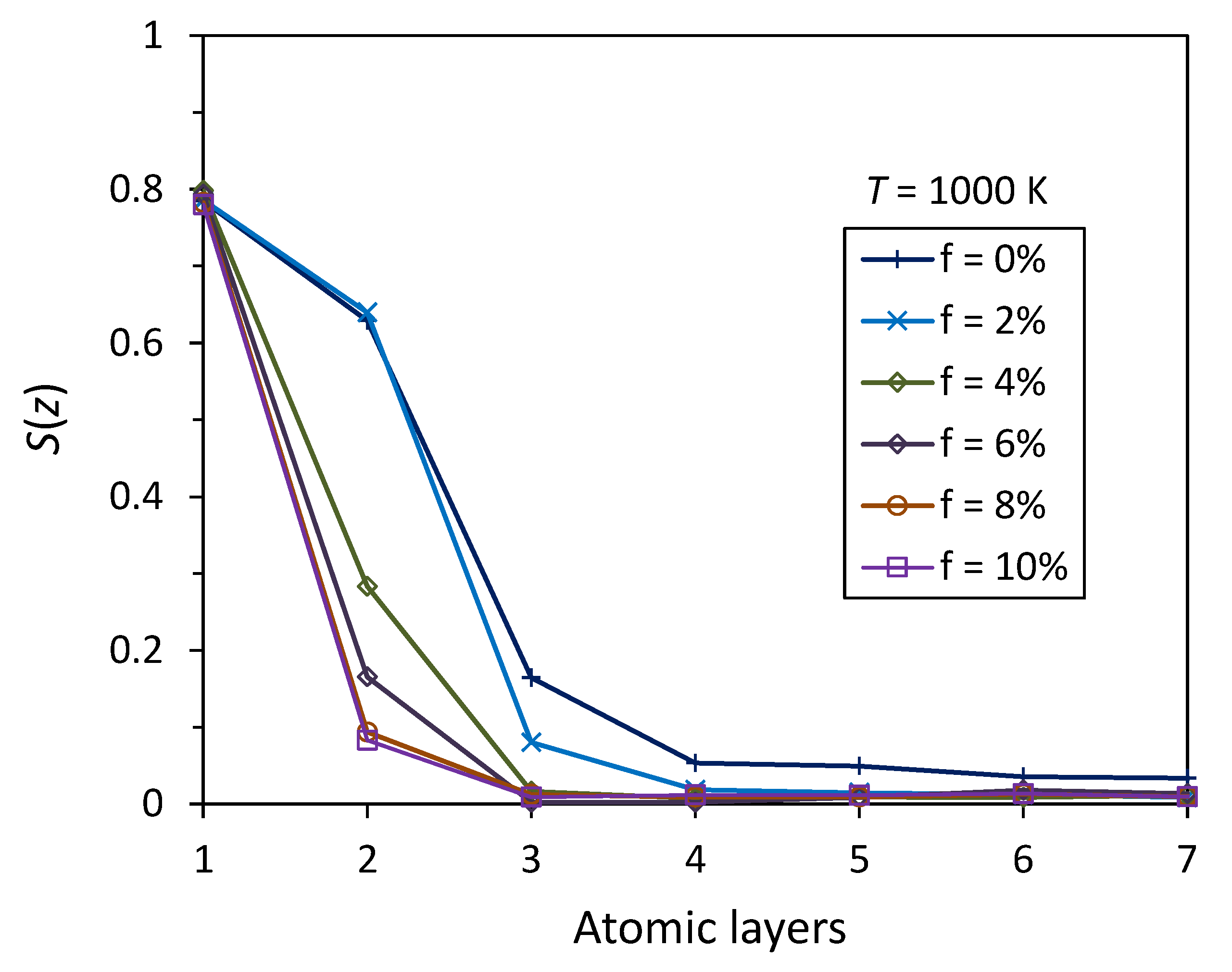
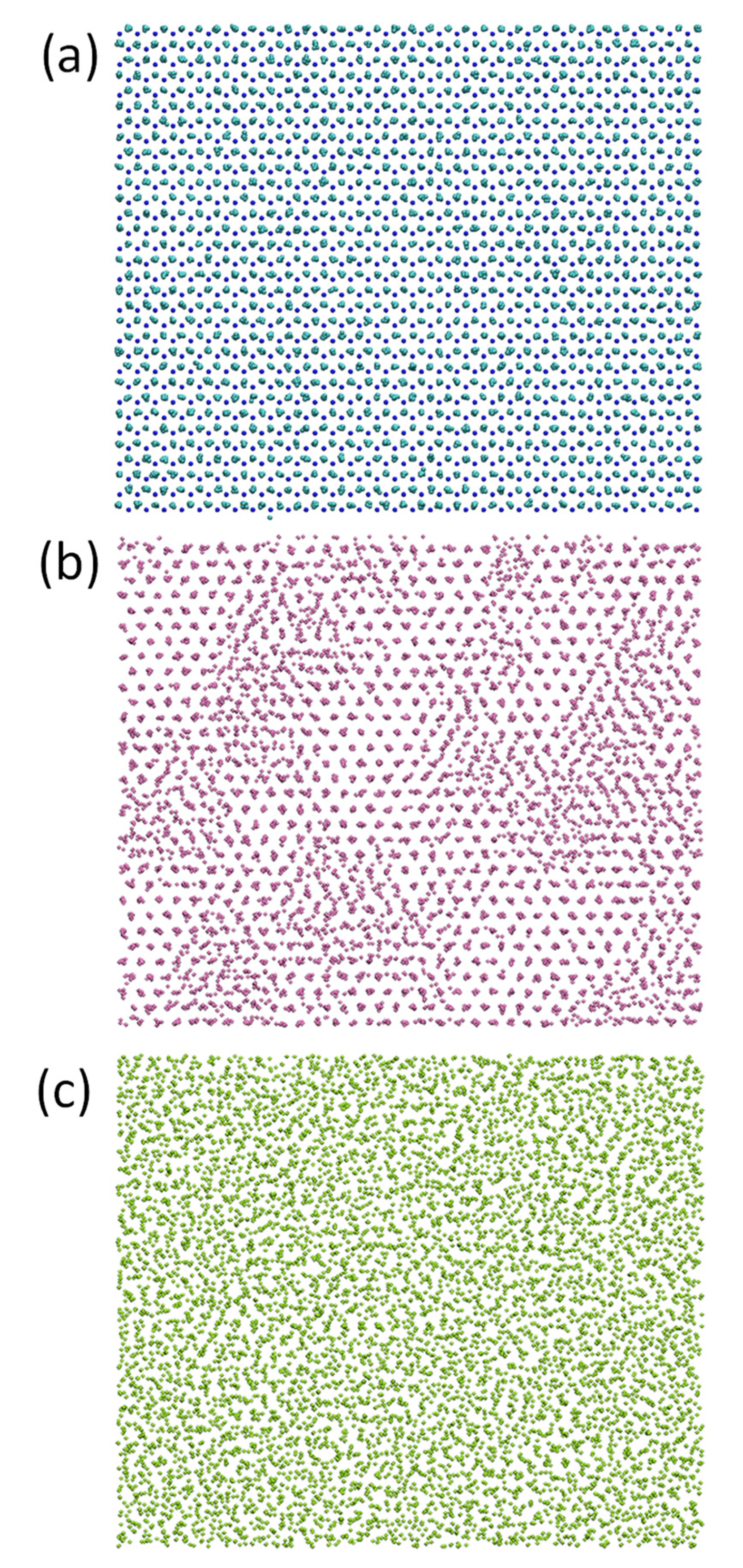
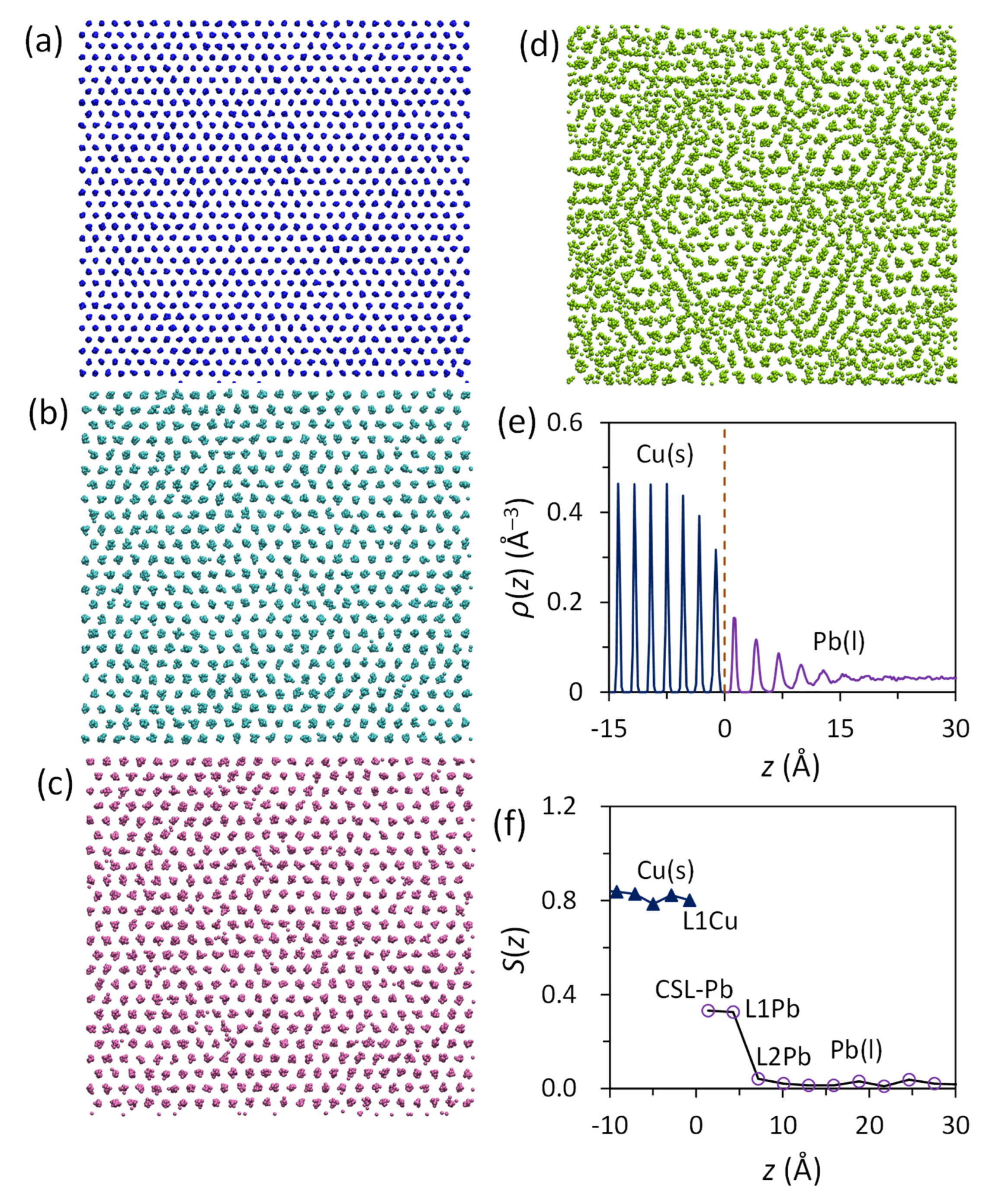
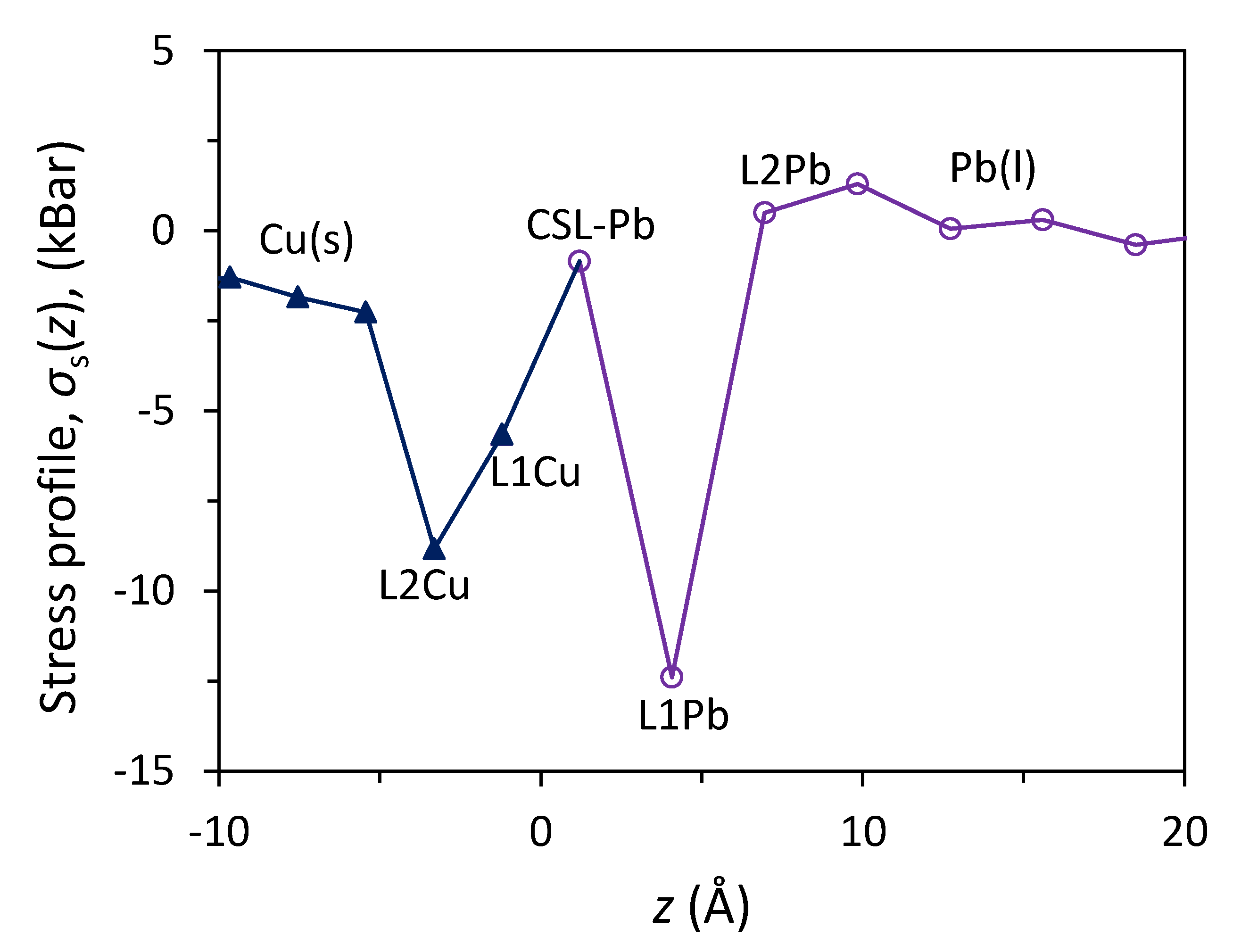

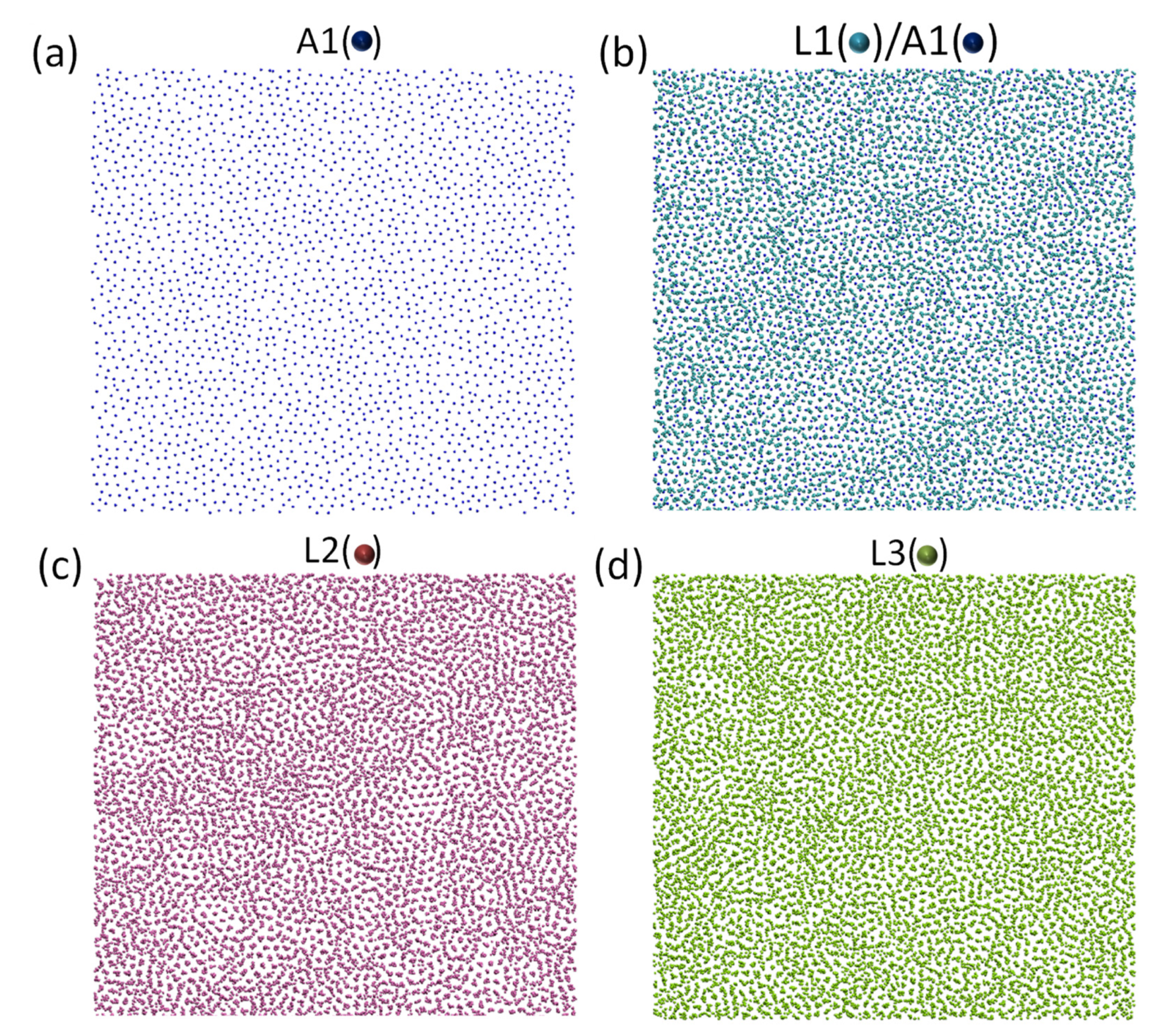

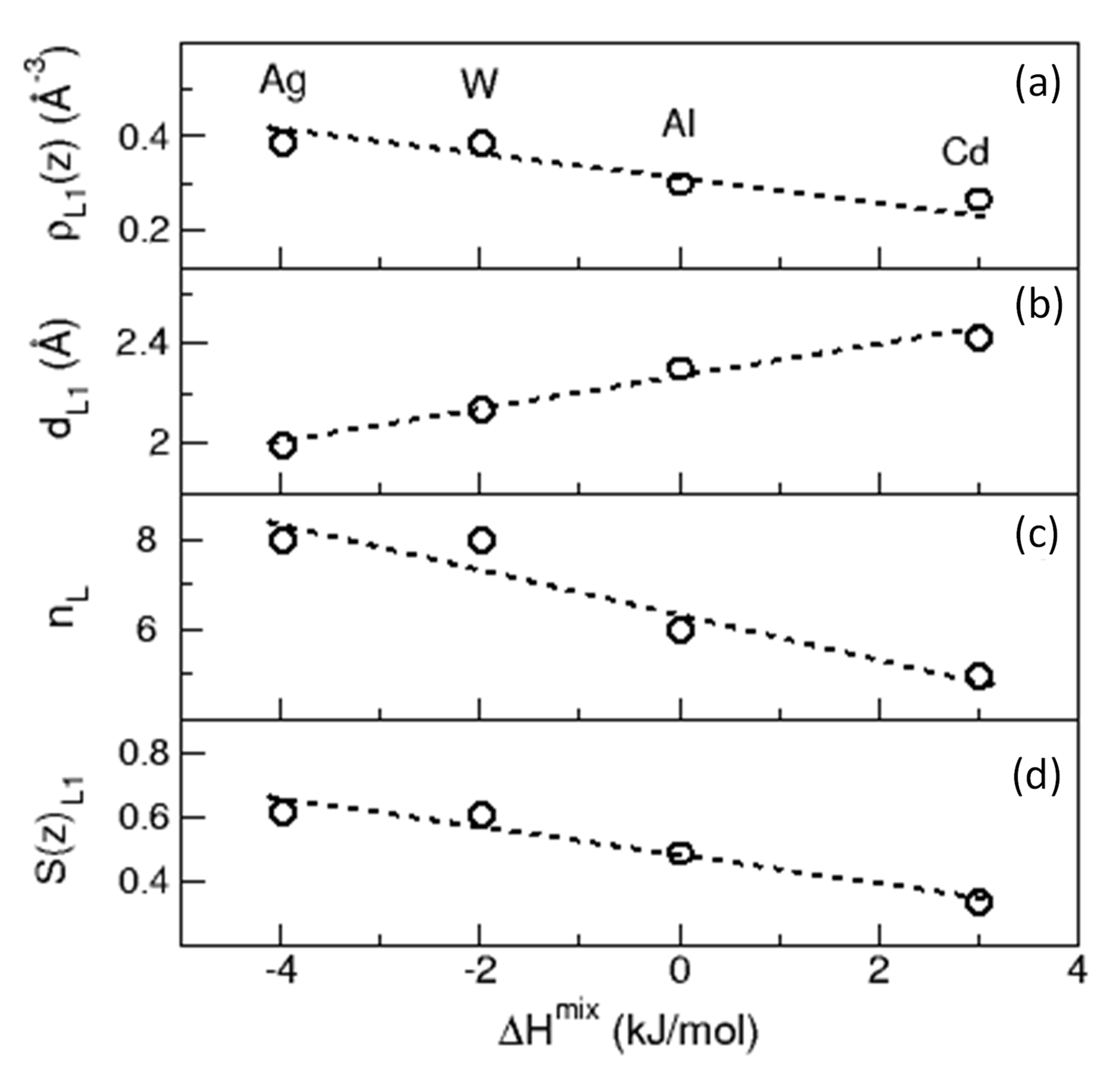
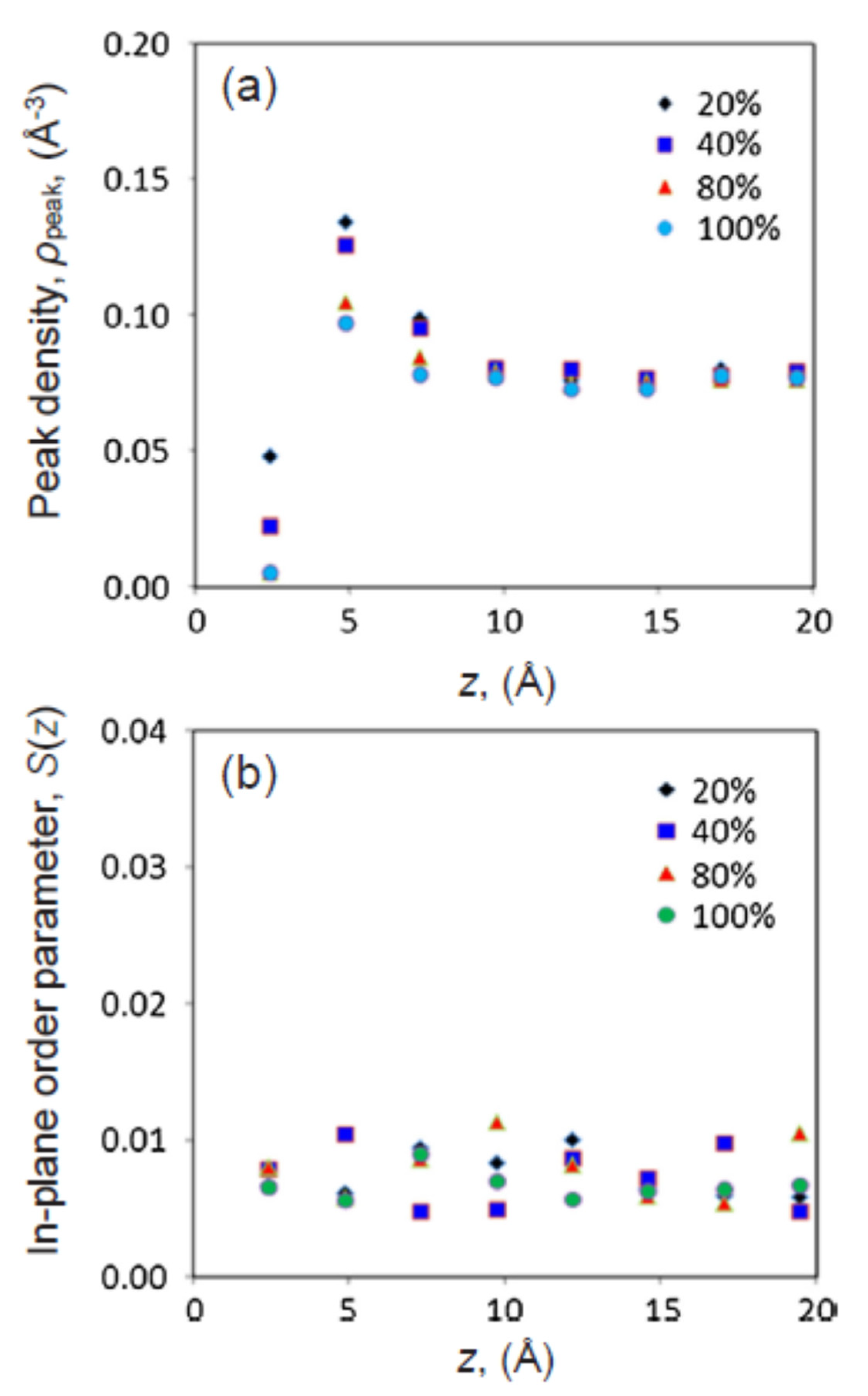
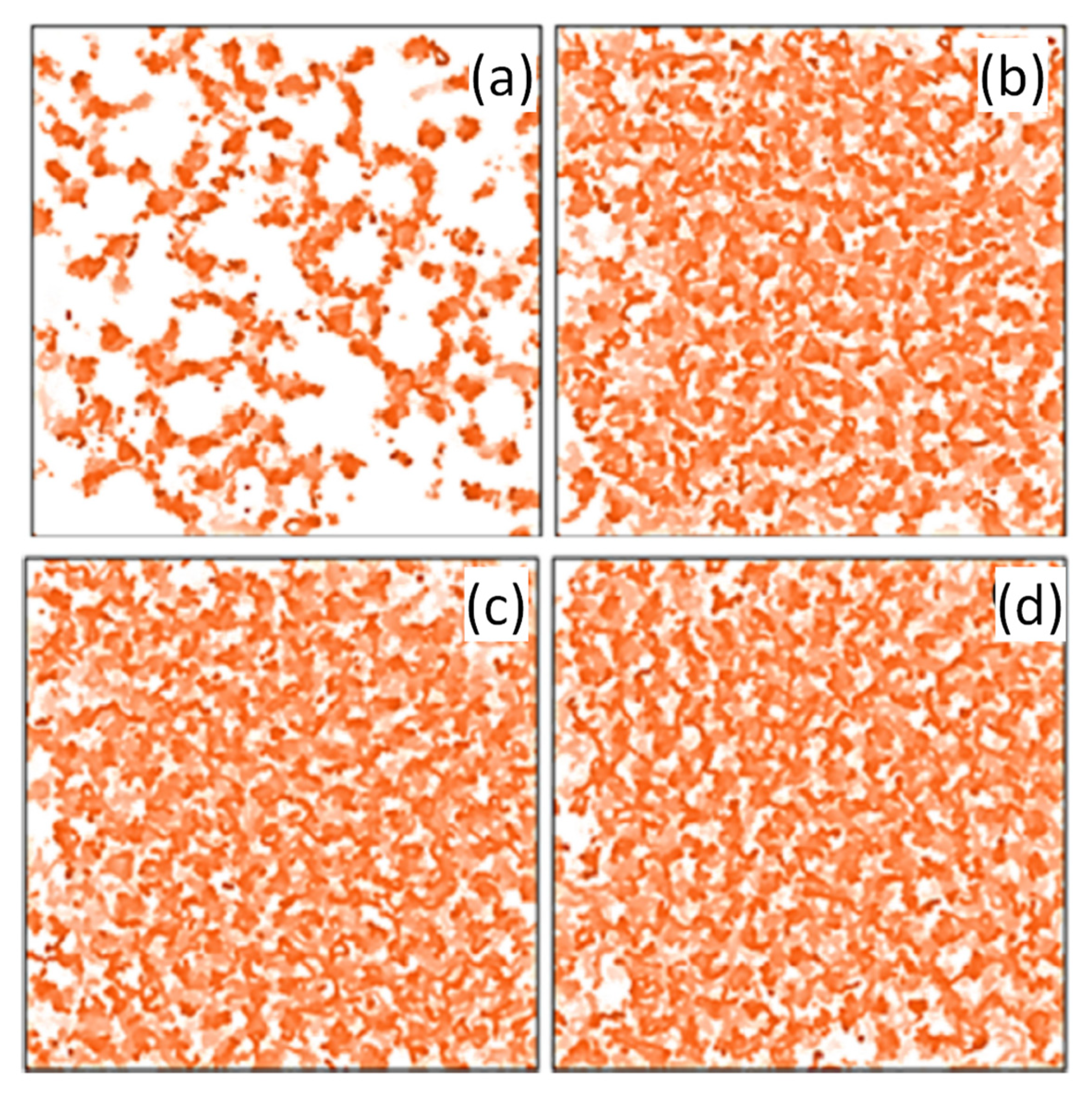
Publisher’s Note: MDPI stays neutral with regard to jurisdictional claims in published maps and institutional affiliations. |
© 2022 by the authors. Licensee MDPI, Basel, Switzerland. This article is an open access article distributed under the terms and conditions of the Creative Commons Attribution (CC BY) license (https://creativecommons.org/licenses/by/4.0/).
Share and Cite
Men, H.; Fang, C.; Fan, Z. Prenucleation at the Liquid/Substrate Interface: An Overview. Metals 2022, 12, 1704. https://doi.org/10.3390/met12101704
Men H, Fang C, Fan Z. Prenucleation at the Liquid/Substrate Interface: An Overview. Metals. 2022; 12(10):1704. https://doi.org/10.3390/met12101704
Chicago/Turabian StyleMen, Hua, Changming Fang, and Zhongyun Fan. 2022. "Prenucleation at the Liquid/Substrate Interface: An Overview" Metals 12, no. 10: 1704. https://doi.org/10.3390/met12101704
APA StyleMen, H., Fang, C., & Fan, Z. (2022). Prenucleation at the Liquid/Substrate Interface: An Overview. Metals, 12(10), 1704. https://doi.org/10.3390/met12101704







